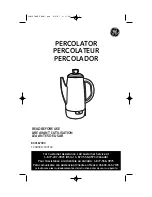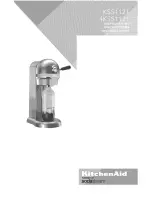
9
fig.9
A
fig.8
Adaptation to a different type of gas
If the appliance is to be converted for use with a type of gas
other than that for which it was set in the factory (indicated
on the label to be found on the hob), the burner nozzles
should be replaced as follows
:
• remove the grids and the burners.
•
U
nscrew the nozzles "A" (fig.9), using a 7 mm socket
wrench and replace them, according to the table 1
"burners and nozzles specifications", with ones suitable
for the new type of gas.
• On completing the operation, replace the old rating label
with the one showing the new type of gas; the sticker is
available from our Service Centres.
• Re-assemble all the components.
Gas supply connection
• Check that the appliance is set for the type of gas available
and then connect it to the mains gas piping or the gas
cylinder in compliance with current regulations and
standards.
• This appliance is designed and set to work with the gas
indicated on the label situated on the actual hob. If the
gas supply is other than the type for which the appliance
has been set, proceed with replacing the corresponding
nozzles (provided), following instructions given in the
paragraph “Adaptation to different types of gas”.
• For trouble-free operation, suitable use of energy and
longer life of the appliance, make sure that the supply
pressure complies with the values indicated in the table 1
"burners and nozzles specifications, otherwise install a
special pressure regulator on the supply pipe in
compliance with current standards and regulations.
• Connect in such a way that the appliance is subjected to
no strain whatsoever.
Either a rigid metal pipe with fittings in compliance with the
standards in force must be used for connecting to the nipple
union (threaded ½"G male fitting) situated at the rear of the
appliance to the right (fig.8), or flexible steel pipe in
compliance with the standards in force, which must not
exceed 2000 mm in length. Should it be necessary to turn
the fitting, the gasket (supplied with the appliance) must be
replaced. Upon completion of installation, check the gas
circuit, the internal connections and the taps for leaks using
a soapy solution (never a flame). Also check that the
connecting pipe cannot come into contact with moving parts
which could damage or crush it. Make sure that the natural
gas pipe is adequate for a sufficient supply to the appliance
when all the burners are lit
Important: A pressure regulator, in compliance with the
standards in force, must be inserted when connecting to a
liquid gas supply (in a cylinder).
fig.10
ELECTRICAL CONNECTION
Adjusting the low flame
• Put the tap to the low flame position (the burner should
be lit);
• Remove the tap knob and turn the adjusting screw,
situated to the side of the tap stem (fig.10) until you obtain
a regular small flame, using a screwdriver (loosening
the screw increases the height of the flame, tightening
decreases it).
N.B. : the adjusting screw must be fully screwed down
for liquid gas.
• Having obtained the low flame setting required and with
the burner lit, abruptly change the position of the knob
several times from minimum to maximum and vice versa
and check that the flame does not go out.
• Refit the tap knobs
THE APPLIANCE MUST BE EARTHED
The appliance is designed to work with alternating current
at the supply voltage and frequency indicated on the rating
plate (situated on the rear part of the appliance and on the
last page of the instruction booklet) or at the end of the
instruction booklet. Make sure that the local supply voltage
corresponds to the voltage indicated on the rating plate.
ATTENTION: This appliance has a maximum power
exeeding 3kW; it is therefore necessary for it to be
connected to a socket able to support a rated current
higher than 13A (the appliance rated current is 15A).
Connecting the supply cable to the mains electricity
supply A 13. A plug in compliance whit BS 1362 is not
suitable.
To connect directly to the mains supply, a double-pole switch
with a contact separation of at least 3 mm suitable for the
load and complying with current standards and regulations,
must be fitted between the appliance and the mains supply
outlet. The yellow-green earth wire must not be interrupted
by the switch. The supply cable must be in such a position
that no part of it can reach a temperature of 50 °C above
room temperature. Do not use adapters or shunts as they
could cause heating or burning. Before connecting to the
power supply, make sure that:
• the limiter valve and the domestic system can withstand
the load from the appliance (see rating plate);
• the supply system is efficiently earthed according to
standards and laws in force;
• the socket or double-pole switch are easily accessible
when the appliance is installed.
FAILURE TO OBSERVE THE ACCIDENT-PREVENTION
REGULATIONS RELIEVES THE MANUFACTURER OF ALL
LIABILITY.
Important: the wires in the mains lead are coloured in
accordance with the following code:
Green & Yellow
- Earth
Blue
- Neutral
Brown
- Live
As the colours of the wires in the mains lead may not
correspond with the coloured markings identifying the
terminals in your plug, proceed as follows:
Connect the Green & Yellow wire to terminal marked “E” or































